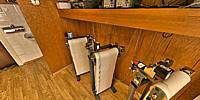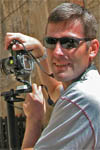© 2013 Boštjan Burger, All Rights Reserved.
Since ancient times, humans observed with curiosity events in nature and around them. They have studied them, adapted to them and learned to turn them to their benefit. The sudden movement of solid ground is certainly one of the most horrible experiences known to humans…
Systematic observation of earthquakes started in about 1750, when England was shaken by several earthquakes. The earthquake on Sunday, November 1st 1755 in Portugal, one of the most catastrophic earthquakes in human history, had even greater influence on the development of earthquake observation. The earthquake and the following tsunami caused the death of 100,000 people in Lisbon. The period following this catastrophe can be marked as the beginning of the modern seismology.
In the late nineties of the last century, the seismic network of Slovenia comprised seven stations. Six of them were equipped with digital seismographs, which were connected over dial phone lines. Data transmission was automatic and the operation was controlled and instruments configured through the central computer on Golovec in Ljubljana. Since the Environmental Agency was established in 2001, it has modernized the national network of seismic stations – which is the responsibility of its Seismology and Geology Office.
Seismic station Ljubljana is at the Astronomical-Geophysical Observatory on Golovec (396 m). It is located in two nearby parts: the first is in the cellar of the observatory building, where the seismic instruments are placed on a specially designed concrete pillar. The second part of the seismic instruments is placed in a 20 m distant shallow shaft. The station has been operating since 1958 and is part of the World seismic network for earthquake recording.
(Source of text: ARSO, Seismology and Geology Office, Seismic Network of Slovenia, Ljubljana 2006)
Lat: 46° 2' 37.69" N
Long: 14° 31' 39.95" E
Elevation: 396 m
Precision is: High. Pinpoints the exact spot.



 Tap or click the zoom icon in the bottom right corner of the picture to switch between in-page and fullscreen view
Tap or click the zoom icon in the bottom right corner of the picture to switch between in-page and fullscreen view